
E-mail: font@focusonnature.com
Phone: Toll-free in USA 1-888-721-3555
or 302/529-1876
Website: www.focusonnature.com
 |
PO
Box 9021, Wilmington, DE 19809, USA E-mail: font@focusonnature.com Phone: Toll-free in USA 1-888-721-3555 or 302/529-1876 Website: www.focusonnature.com |
 A Focus On Nature
Tour
A Focus On Nature
Tour
in
Japan
For
Birds in the Winter
on 4 Islands
Honshu, Hokkaido, Kyushu,
and Amami
(Amami is optional)
With
Sea-Eagles (2 species)
and Cranes (as many as 7 species),
Also with a visit to a river with hundreds
of wild Mandarin Ducks (maybe
more).
And our quest for the massive, rare
Blakiston's Fish Owl.
(During all of our previous tours,
we've seen it.)
(tour: FON/JA-1a'17)
January 19-31, 2017
With the
optional extension to Amami:
(tour FON/JA-1a&b '17)
January
19 - February 4, 2017
FONT
has been doing
Japan birding & nature tours
for a more than a decade.
This to be our 42nd tour in Japan!
Itinerary follows below
LINKS:
A List & Photo Gallery of Japan Birds, in 2 Parts:
Part 1:
Pheasants to Pittas
Part
2: Minivets to Buntings
Birds during previous FONT Fall & Winter Japan Tours
Rare Birds during our Japan Tours
Mammals of
Japan
(with
some photos)
A magnificent sight to
be enjoyed during this tour are dancing Red-crowned, or Japanese Cranes in the
snow. Only in Japan in Hokkaido, and there only locally.
At one time, back in
1924, there was just a very small population of this species - less than 20.
From that brink of extinction, the number increased to over 900 birds in
Hokkaido, during the 2004/05 winter, and more than a thousand since
then.
A flock of these cranes, or "tanchos"
as they are known in Japanese, is one of the nicest wintertime spectacles, not
just in Japan, but anywhere.
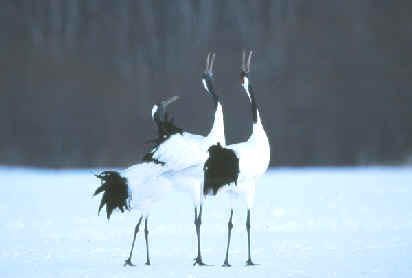
Thu, Jan. 19: Arrival at Narita-Tokyo Int'l. Airport (about 2 hours north of Tokyo). Transfer to overnight in the area of Narita (at a western-style hotel).
Fri, Jan. 20: Travel from Narita to the area of Karuizawa (in the mountains of Honshu about 2 hours north of Tokyo), with some birding along the way. Our first of 2 overnights in the Karuizawa area.
Sat, Jan. 21:
A full-day of birding in the picturesque Karuizawa area, for birds such as the
endemic Copper Pheasant, Japanese Waxwing, and the Pallas' Rosefinch
(the last of these has been seen nicely during our winter tours in this region,
as have been Long-tailed Rosefinch, Japanese Accentor, Grey Bunting, and
Japanese Grosbeak).
Sometimes, during winter, in the Karuizawa area, Solitary
Snipe can be found.
Another possibility is the Baikal Teal, a species that
has been declining. Mandarin Ducks should be seen.
In the non-bird realm, we'll
also have a good chance to see the Japanese Macaque.
Overnight again near
Karuizawa.
Sun, Jan. 22:
Another
morning of Karuizawa birding.
In the afternoon, travel to where the ferry will
depart for Hokkaido, departing late at night from north of Tokyo. Sleeping accommodations
at night onboard the ferry.
Mon, Jan. 23:
Pelagic
birding onboard the ferry from Honshu to Hokkaido, mostly off the coast of
northern Honshu. A full-day at sea as we travel north. A number of pelagic birds are
possible, including the Laysan Albatross (we've
seen as many as 500 to 1000 during previous tours, although recently, for some
reason, in the winter far less have been seen).
We've also seen been lucky
to see on a couple occasions from the ferry the rare Short-tailed Albatross.
More likely will be various alcids, including both murres, Ancient
Murrelet, and
Least Auklet. (During one ferry trip, we saw an estimated
25,000 Crested Auklets).
During one of our trips on this ferry, offshore from northern
Honshu, a Gyrfalcon flew by the boat, then circled above us before
heading toward the coast.
On another occasion, in that same
area, a Short-eared Owl flew by the boat. So, as always, you never know what
you'll see at sea.
After dark, we'll
arrive at Tomakomai, in Hokkaido.
Overnight there.
Tue, Jan.
24:
After some morning birding in southwestern
Hokkaido
(in the area of a lake
near Tomakomai),
we'll
travel east toward
Kushiro,
where we'll spend the night.
That will put us in position for our upcoming wonderful experience with the Japanese
Cranes the next morning.
This day, as we travel from west to east, there
could be a number of nice birds such as tits, including the Varied,
finches including Asian Rosy and Bullfinches (both nice
to see in the snow), and woodpeckers (such as the White-backed
and the Black).
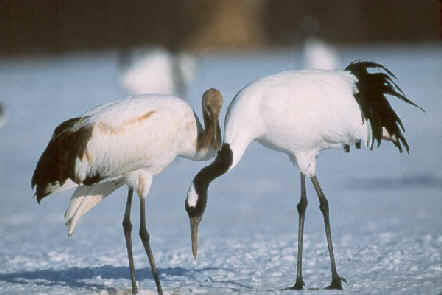
Young & adult Japanese Cranes
photographed
during a FONT tour in Hokkaido
Wed, Jan. 25:
This day, as our birding in southeastern Hokkaido begins
- in the Kushiro
area, a time that we should always remember, as we enjoy the sights and sounds of the Red-crowned or Japanese
Cranes. Beautiful sights and sounds, as they dance and call, or even just
stand, in a flock on the snow.
(They're beautiful, it should be noted, even
without snow.)
Part of our experience, in the afternoon, at
the crane site, is the feeding of small fish (eaten by the cranes, yes, but even
more dramatic is the swooping in of either, or both, of the sea-eagles
- the White-Tailed and Steller's). Our overnight
to be at a hotel in nearby eastern Hokkaido coast.
Thu, Jan. 26:
From our hotel, our first morning objective will be, along the coast, the
renowned concentrations of two sea-eagles, Steller's and White-tailed.
During this day, we should have some tremendous coastal birding at
various habitats including lofty cliffs and expansive dunes by the sea.
Our
especially good birds could include, in addition the eagles, some alcids
including the Spectacled Guillemot (endemic to the northwestern
Pacific), and numerous waterfowl including Whooper Swans and
some ducks quite attractive: Smews and Harlequins (the
latter can be in large flocks).
We could, with luck, have a "steller time" with the likes of the
Steller's Sea-Eagle, Steller's Eider, and Steller's Sea Lion.
And another tremendous bird this day should be the rare
Blakiston's Fish-Owl, which is not only one of the rarest, but also one of
the largest of all the owls in the world. We've seen it during all of our
previous tours. And we intend to do so during this tour, as well - either this
evening, or, if conditions warranted, the previous evening. (If
we can, we go for the owl the first night possible, as one never knows what's
ahead with the winter weather on Hokkaido.)
Our last
night in Hokkaido, further inland, by a national park with volcanoes, hot
springs, a large lake and wonderful forest.

A view of a volcano, forest,
and large lake in Hokkaido, Japan
Fri, Jan. 27:
In the morning, firstly, a visit to the large lake normally mostly frozen, but
with a gathering of Whooper Swans where the water is open. The swans,
usually vocal and with a repertoire of motions, will be close to us, in the mist
rising from the lake.
This day, we'll travel to the airport for a flight to the Tokyo Haneda
Airport. From there, we'll take a connecting flight south to the southernmost of
the main Japanese islands, Kyushu.
Upon arrival
there, at Kagoshima, we'll travel, about an hour west, so
that the following morning, we'll be with the thousands of cranes,
that come from
mainland Asia to winter in that part of Japan. This to be our first overnight in
southern Kyushu.
Sat & Sun, Jan.
28 & Jan. 29:
Two days
with what ordinarily has been for us, over the years, some extraordinary birding in
southern Kyushu, at various places including the
Arasaki Crane Reserve,
near Izumi, one of the most bird-rich locations in Japan during
November-February.
More than 60 species
have been routine for us in that area that time of year.
Among them, some of the more unusual birds can include: Chinese
Penduline-Tit, Daurian Jackdaw, and the Pallas' Bunting.
However, the
area is most renowned for it cranes - having one of the largest concentrations of
wintering cranes in Asia - 8,000 birds, virtually all of them Hooded
and White-naped Cranes.
Just about all of the world's Hooded Cranes
(about 6,000 birds) winter in the area, and for the elegant White-naped
Crane, it is their only wintering site in Japan (about 2,500 birds).
Other species of
cranes, rare in that part of the world, are possible as well, such as the Common
and the Sandhill (that the Japanese call "Kanada-zuru" -
"zuru" means crane in Japanese).
Here, in the
past, a few times, we've seen the very rare Siberian White Crane and
we've also seen the attractive
Demoiselle Crane. Virtually every winter some of the unusual
cranes occur at Arasaki.
We've seen as many as 7 species of cranes in the
area, as one time, in February 2005, we saw a single, rare, immature Red-crowned Crane
(apparently from the population known as the "Manchurian Crane" - the
first such occurrence there in 37 years).
Other notable bird species for us in
southern Kyushu have included the Black-faced
Spoonbill and Saunder's Gull, both rarities.
For us, once, another
rarity was seen, the Oriental White Stork.
Both nights, January 28 & 29,
will be in southern Kyushu.
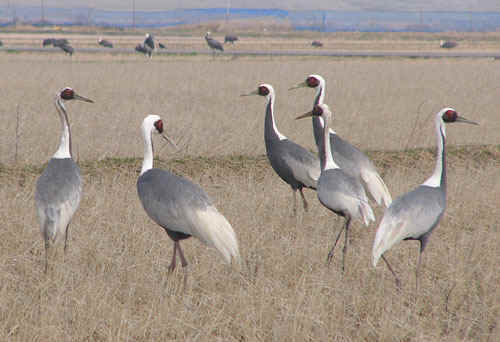
White-naped Cranes
photpgraphed
during a FONT tour in Kyushu, Japan
Mon, Jan. 30: More
Kyushu birding
this
day, in the forested highlands including and near the Ebino
Plateau (a volcanic
area with hot springs), in the Kirishima-yaki
National Park.
One of our avian objectives will be the Copper Pheasant,
a Japanese endemic not commonly seen (but we saw it well during some of our recent
tours).
Our number of Mandarin Ducks for the day could reach
the thousands. Many occur in a particular valley that we'll visit, where there
would also be Brown Dipper and Crested Kingfisher.
In these hills, during one of our
February tours, we had tremendous looks of the Mountain, or Hodgson's,
Hawk-Eagle, 3 birds, in flight and perched.
There should also be a fine assortment of
other woodland birds, among them the colorful
male Red-flanked
Bluetail, and a few species of buntings, including the attractive Yellow-throated.
During one of our previous tours in this area of southern Kyushu, we had a
wonderful look, late in the day, at a Ural Owl.
Our last overnight in southern Kyushu.
Tue, Jan. 31:
From the Kagoshima Airport
either departure for home, (or for those continuing on the tour to
Amami, a flight to
that more southerly, and smaller Japanese island).
Amami
is a subtropical, hilly, forested island surrounded by coral reefs, with traditional
culture, and a number of endemic and specialty birds. Our birding there will be
begin when we arrive on the island mid-day. Our first of 3 nights on Amami.
Wed &
Thu, Feb. 1 & 2:
Two full-days of
birding on Amami (with birding after dark as well for owls
& a woodcock).
On the island, among the endemic and rare birds to be found: the beautiful
Lidth's Jay, the rare Amami Thrush, the dapper Ryukyu Robin, and
the "Owston's" or Amami Woodpecker.
Among the owls:
the Ryukyu Scops-Owl.
The woodcock, a declining species that's
nearly endemic to the island, the Amami Woodcock.
As an island, Amami, with a strategic location, can have some interesting
birds in addition to the endemic residents.
For example, once in January, Spoon-billed
Sandpiper and Silky Starlings (from China) were present.
During another one of our January tours: Bluethroat and Red-throated Pipits
were just outside the door at the airport.
And yet during another January FONT tour on Amami,
Greater Sand Plover and Saunder's Gull were seen.
So there is the
potential for the unexpected.
Twice Focus On Nature Tours made the newspapers in Amami (for bringing
bird-watchers from throughout the world.)
During those and other tours, our
tour participants have been from England, Holland, Germany, France, Australia,
Thailand, Canada, and the USA.
We look forward again to visiting Amami in 2017. Our nights there at a hotel in Naze.
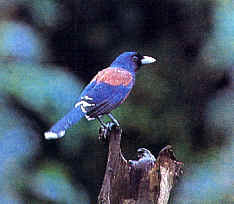
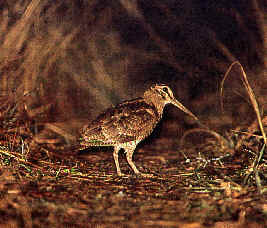
Two of the bird
specialties of Amami Island,
the Lidth's Jay & Amami Woodcock.
Fri,
Feb 3: After some final morning birding, a flight from Amami to
Kagoshima, Kyushu, where we'll connect to a flight to Tokyo. From there, a
transfer to Narita, where we'll spend our last night in Japan.
Sat, Feb 4: Departure for home from Japan.
Note:
![]()
Prices:
US$ 4,795 - per person (from Narita-Tokyo airport), based upon double-occupancy
(including Amami Island).
US$ 3,895 - per person (from Narita-Tokyo airport), based upon double-occupancy
(not including Amami Island).
Single-supplement: $395 including Amami, $335 not including Amami.
(Single occupancy may not be available for
the one night onboard the ferry from Honshu to Hokkaido.)
Prices for 2017, subject
to change. But the price in effect at the time of registration is guaranteed.
Includes:
All
overnight accommodations. (Most to be in "western-style" hotels.)
Meals (except those on Jan. 19 & Jan 31 or Feb 4).
(Most meals
can be "western" or "Japanese" as participants desire.)
All
ground transportation in Japan.
Services of FONT birding leader and local guides.
Does not include:
Drinks and other items of a personal nature.
Air transportation (to/from & within Japan).
"Focus on Nature
Tours" can arrange economical fares for the flights to/from and within
Japan.
Please contact us regarding the best fares possible.
Participants
can opt to do their own flights to/from Japan
(maybe with "frequent flyer
miles").
But, FONT will handle Japanese domestic flights during the tour.
The leader for this
tour will be Armas Hill, who has birded in Japan
numerous times since 1984.
A deposit of US $500 is required to register for this tour.
Our Japan tours usually fill-up early, so you may wish to consider registering as soon as possible.